North Coast 500 motorhome Guide- Route, Highlights and Tips
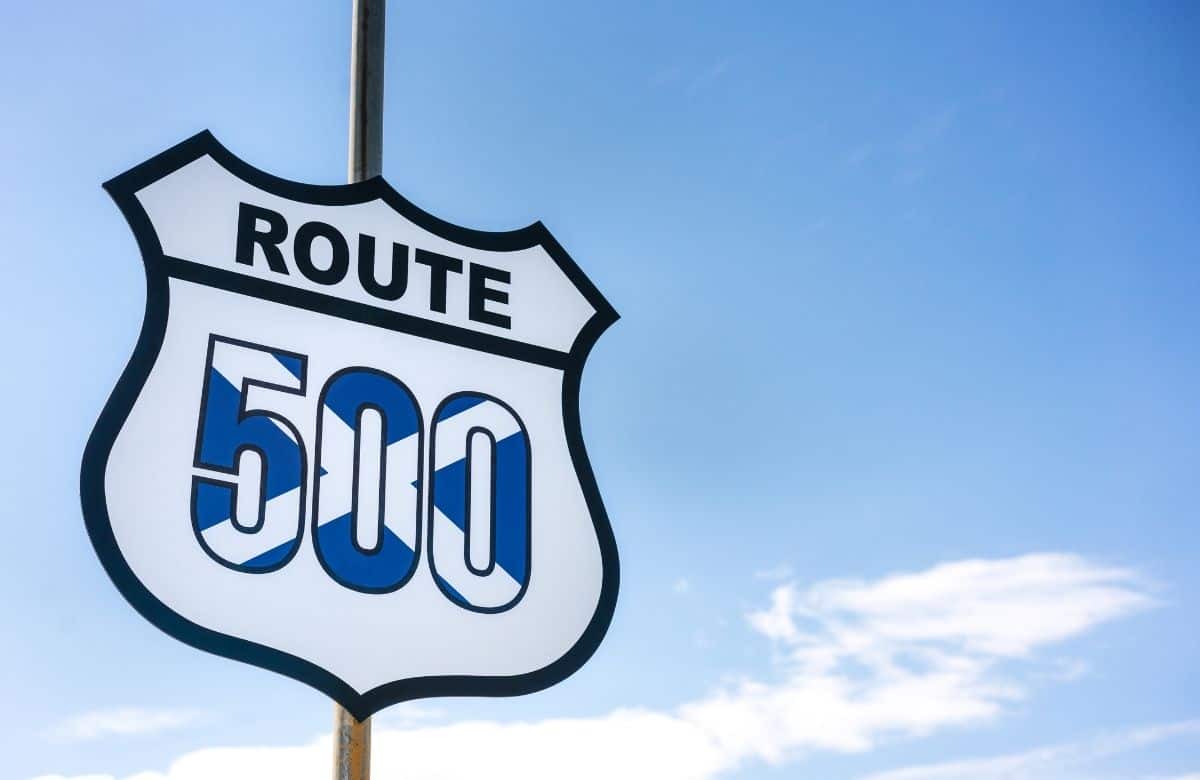
Planning to drive the North Coast 500 (NC500) in Scotland with a motorhome or campervan? Want to know the route, highlights and places to see along the way, campsites, wild camping and tips? Here’s everything you need to plan your North Coast 500 motorhome or campervan road trip.
Don’t forget to grab your FREE NC500 motorhome itinerary below to find some of the best places to visit
*We work hard to make this the best motorhome travel blog and road trip website possible, full of helpful content for you. The website is supported by our readers, so if you buy through links on this site we may earn a commission- at no extra cost to you. All opinions remain our own.
If you find this post useful, you can also treat us to a coffee – we promise to enjoy it while creating more useful content like this- we might even indulge in a biscuit (or two!)
JUMP AHEAD TO...
North Coast 500 Motorhome Trip
The North Coast 500 is a circular driving route in Scotland, created by the Scottish Tourist Board to encourage people to visit parts of the country which are off the beaten track.
It was created several years ago, and is now known as one of the most scenic drives in Scotland, encompassing breathtaking beaches, rugged and wild landscape and some incredible views.
How long does it take to drive the NC500 in a motorhome?
The route is 516 miles long (hence the name!), although there’s nothing to stop you veering off and exploring additional places and attractions along the way, such as the Isle of Skye or even a trip to Orkney.
Remember, although it’s ‘only’ 500 miles, you will be driving mostly on small, windy country lanes and therefore will not be going fast, especially if you’re driving in a motorhome.
At best, you can expect to do 30mph on many sections- and that’s assuming there is no farm traffic or wildlife in the road.
There are also PLENTY of highlights and places to see along the NC500 route, so you will probably be stopping regularly, either for hikes, photographs or picnics.
Taking all this into account, we recommend allowing at least a week to drive the North Coast 500 in a motorhome, campervan or even a car. This is the 7-10 day itinerary and North Coast 500 route planner we used.
It is possible to do it in less, but you’ll miss a lot. Conversely, some people allow two or even three weeks to explore the route and all it has to offer.
One of the huge advantages of driving the North Coast 500 with a motorhome is that you have your home with you, meaning you don’t need to rush quite so much to make a certain town where you’ve booked a hotel reservation.
We’ll talk about wild camping with a motorhome along the NC500 shortly, but if you are going to book campsites in advance (essential in summer), then be sure to allow plenty of time to get there.
Is the NC500 suitable for motorhomes or campervans?
So, with all these small lanes, can you really drive the North Coast 500 in a motorhome?
Absolutely… with conditions.
Firstly, expect to have to reverse your vehicle frequently, especially on the sections which are single lane with only passing points to let traffic from the opposite direction pass (a motorhome reversing camera is ESSENTIAL in these situations.)
You will need to be able to reverse your vehicle along a narrow lane both in a straight line and around tight corners, until you reach the previous passing point.
If you are unable or unwilling to do this, a North Coast 500 motorhome tour might not be right for you. (Don’t worry, there are plenty of other places to visit on a UK motorhoming holiday.)
READ MORE: The BEST NC500 campsites for motorhomes and campervans
Driving Bealach Na Ba/ Applecross Road with a motorhome
This is the road between Ardarroch and Applecross- either called Bealach Na Ba or the Applecross Pass. It’s one of the steepest roads in the UK and has a sign at the beginning warning learner drivers and drivers of large vehicles to go around.
Here’s the deal on if you should drive Bealach Na Ba with a motorhome or not:
- If you have a motorhome longer than 8m, go around.
- If you are towing a trailer/ have a caravan, go around
- If you are a new driver/ hiring a vehicle which you’re not used to/ are a nervous driver (no shame), go around.
- If you have nervous passengers, go around (it’s not worth scaring someone just for a pretty view)
- If you are driving on your own, think very carefully before driving it. Many of the hairpins are easier if you have a spotter to look for oncoming traffic.
- If the weather is bad/ heavy rain/ snow/ thick fog- go around. You won’t see any of the views anyway.
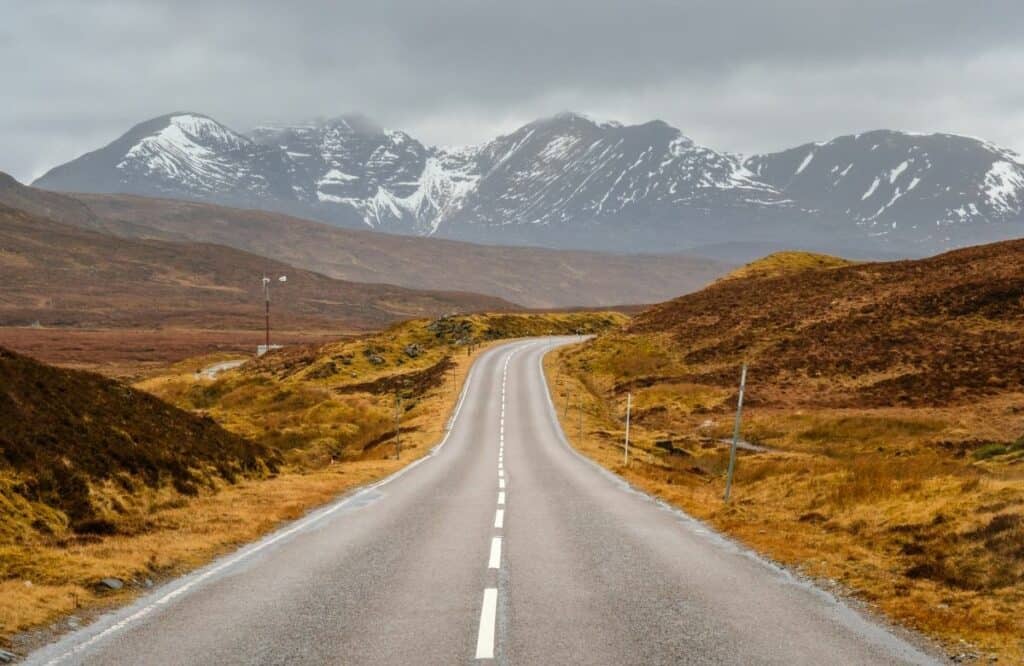
Having said all the above, I drove Bealach na Ba in my motorhome, on my own, in thick fog. And it was fricking epic! 🙂
If you have done any driving in big mountains with a motorhome, like the Vrsic Pass in Slovenia or up in the Alps, and are confident with hairpin bends, reversing, letting traffic pass and dealing with other road users, you will be absolutely fine.
The views are SPECTACULAR and well worth the effort. I would strongly recommend staying nearby and driving this road as early as you can- first light is perfect.
Get there before the tourist buses and idiots who don’t understand how a large vehicle needs swinging room in order to go around corners.
Just remember, local lorries use this road daily without any issue- it’s the tourists who often cause the problem.
Still, if you’re not sure, the alternative route is very scenic too, so either way works.
B869 from Lochinver to Kylesku
Another road which can cause issues is the B869 from Lochinver to Kylesku. If you are heading to that peninsula, take the A837 back East and then stay on the A894 and you will be fine.
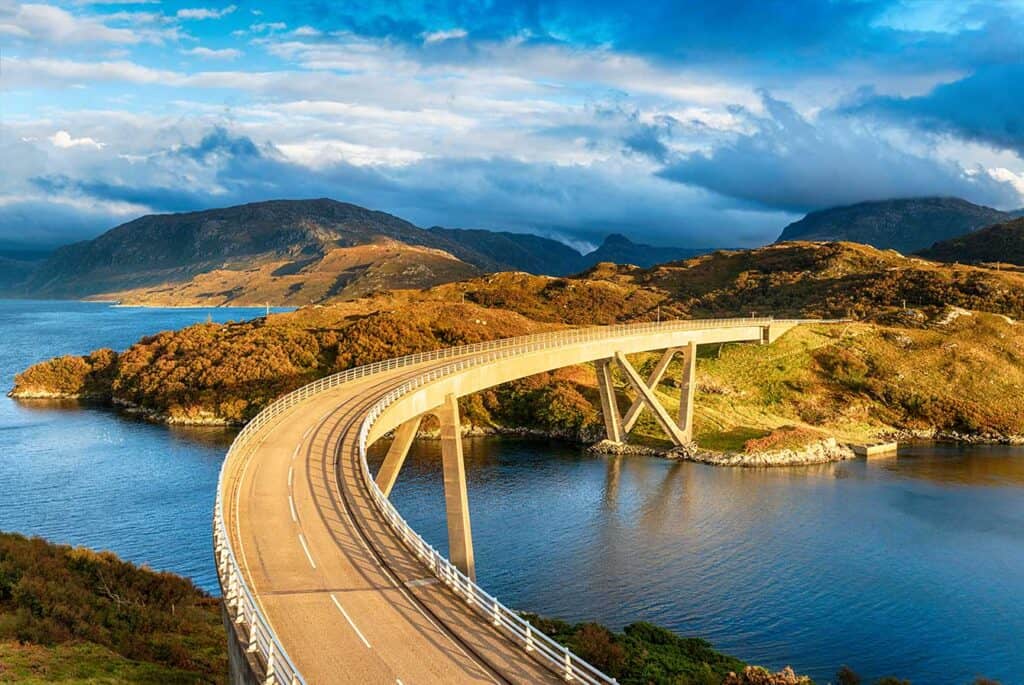
Highlights of a North Coast 500 motorhome trip
Some of the best places to see on the NC500 motorhome route include:
- Smoo Cave
- Clashnessie Falls- this was magic!
- Inverness- the most northerly city in the UK
- Corrieshalloch Gorge
- Bealach Na Ba- the UK’s steepest road.
- Clachtoll Beach
- Kylesku Bridge
- John o’Groats
- Dunrobin Castle
- Brora Beach
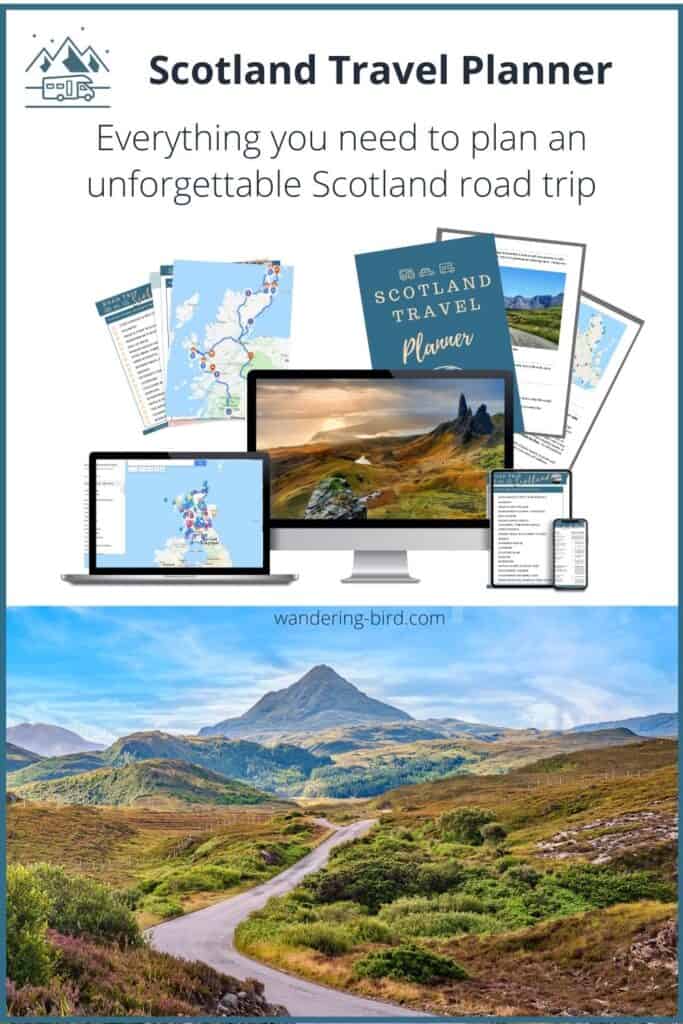
Planning a trip to Scotland?
We’ve done the hard work for you!
Grab our complete Scotland travel planner and get:
- 80+ ideas for places to visit
- Maps and itinerary suggestions
- Routes and things to see along the way
- Tips, customs and much much more!
North Coast 500 Route Planner
The NC500 is circular, which means you can join and leave the route wherever you like. There’s also nothing to stop you only driving a small section of it- like we included in our 10-day Scotland road trip itinerary.
Traditionally, the route begins and ends in Inverness, at the castle. From here, you can choose whether you go around the route clockwise or anticlockwise. The most popular route is clockwise, but it really doesn’t make much difference.
The route is fairly well signposted, and much of it is along quiet and remote lanes, so there’s not too much chance of getting lost (however, you can always put the route into your motorhome sat nav, just in case!)
North Coast 500 Route Map
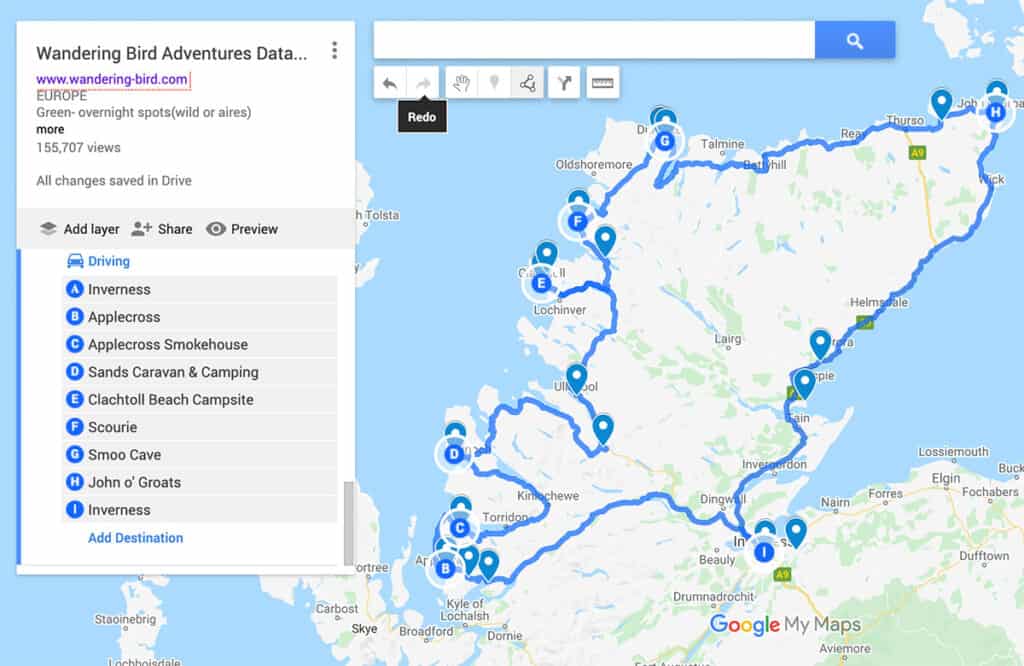
North Coast 500 motorhome Itinerary
To give you an idea, here’s a rough itinerary for driving the North Coast 500 with a motorhome or camper (or even a caravan!)
Day One- Inverness to Ardarroch
Distance: 68 miles
Estimated Time: 1h 30 minutes driving
Campsite Suggestion: The Wee Campsite– small but with great views of the loch.
If you have time, head east from Inverness to visit the historic Culloden Moor and learn more about the clans, the battle and the history of the area. It’s incredibly moving and well worth a visit before you head off into the Highlands.
It’s also worth a visit to Eilean Donan castle, and if you can, do a detour to the Isle of Skye for a day or two.
Day Two- Ardarroch to Applecross/ Sands
If you want to drive Bealach Na Ba, get up early. If not, go around.
Distance: 76 miles in total- 12 miles over the pass, then another 17 miles to the Applecross Smokehouse, and 47 miles to Gairloch
Estimated Time: 2h 45 minutes if you don’t stop (which you will!) 35 minutes driving (plus extra for photo stops) over the pass, 38 minutes around the coast, then another 90 minutes up to Gairloch and Sands campsite
Campsite Suggestion: Sands Campsite in Gairloch- stunning views. Stay here a night or even two if you have time.
Of course, you can split this into two days, and stay at Applecross for a night if you wish before driving up to Gairloch.
Day Three- Gairloch to Clachtoll Beach
This is when you need to start making some tough choices if you only have a few days to do the entire North Coast 500 route, as it’s impossible to see everything.
One of the best campsites along the west coast of Scotland is Clachtoll Beach so, whatever you decide to see on the way, that’s where I recommend ending up for the night (in high season, you may need to book for a couple of nights.)
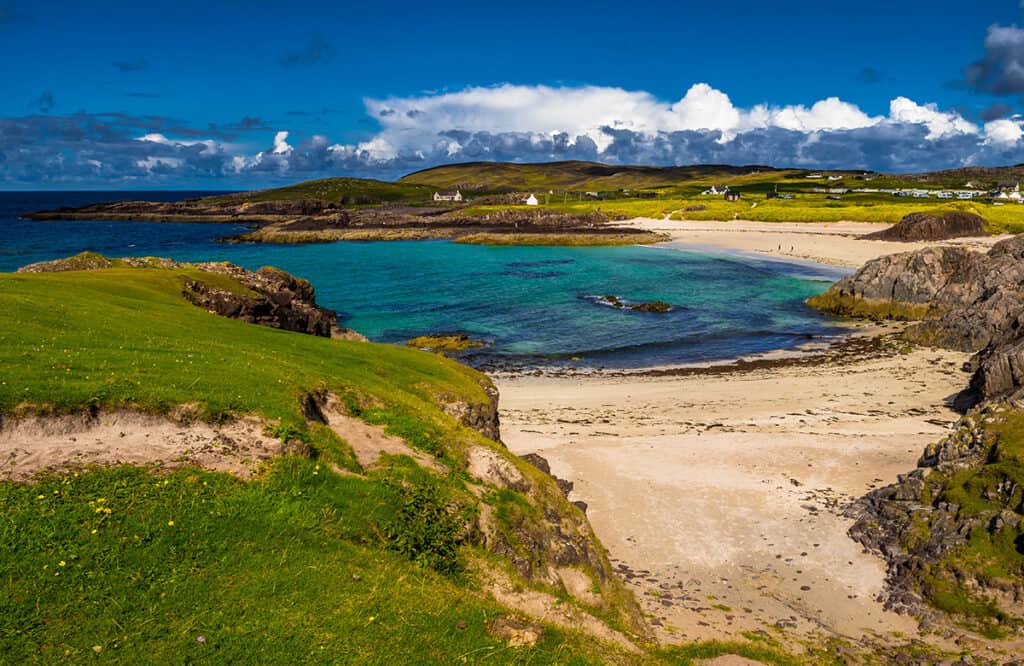
As I mentioned before, it’s impossible to do everything in this area, especially if you only have a day or two.
Corrieshalloch Gorge is worth a visit and so is Clashnessie Falls, which is near the breathtaking Clashnessie beach. Ullapool, Lochinver and Achiltibuie all deserve a visit too, so do your research and see what appeals most.
Day Four- Clachtoll to Durness
Another longish day which can easily be broken into 2 or even 3 days if you have time.
Today you’ll drive over the famous Kylesku Bridge, as well as enjoying some more incredible scenery. There are plenty of places to stop along the way and walk/ enjoy the scenery, just be sure to park well out of the road. Wailing Widow Falls is a popular stop.
Near Durness, you’ll also find Smoo Cave, which is well worth a visit.
Smoo Cave is the largest natural sea cave in the British Isles, with evidence of human inhabitance from as early as 8000 BC!
The cave is just a mile east of Durness Village and is well signposted. It’s free to walk to and around the cave and there is often a waterfall inside during wet weather.
You can also take a boat tour to the cave. You can’t book the boat- it’s run on a first-come, first-served basis and only when the weather and water conditions are right. The tour takes about 20 minutes (price is around £6pp in cash)
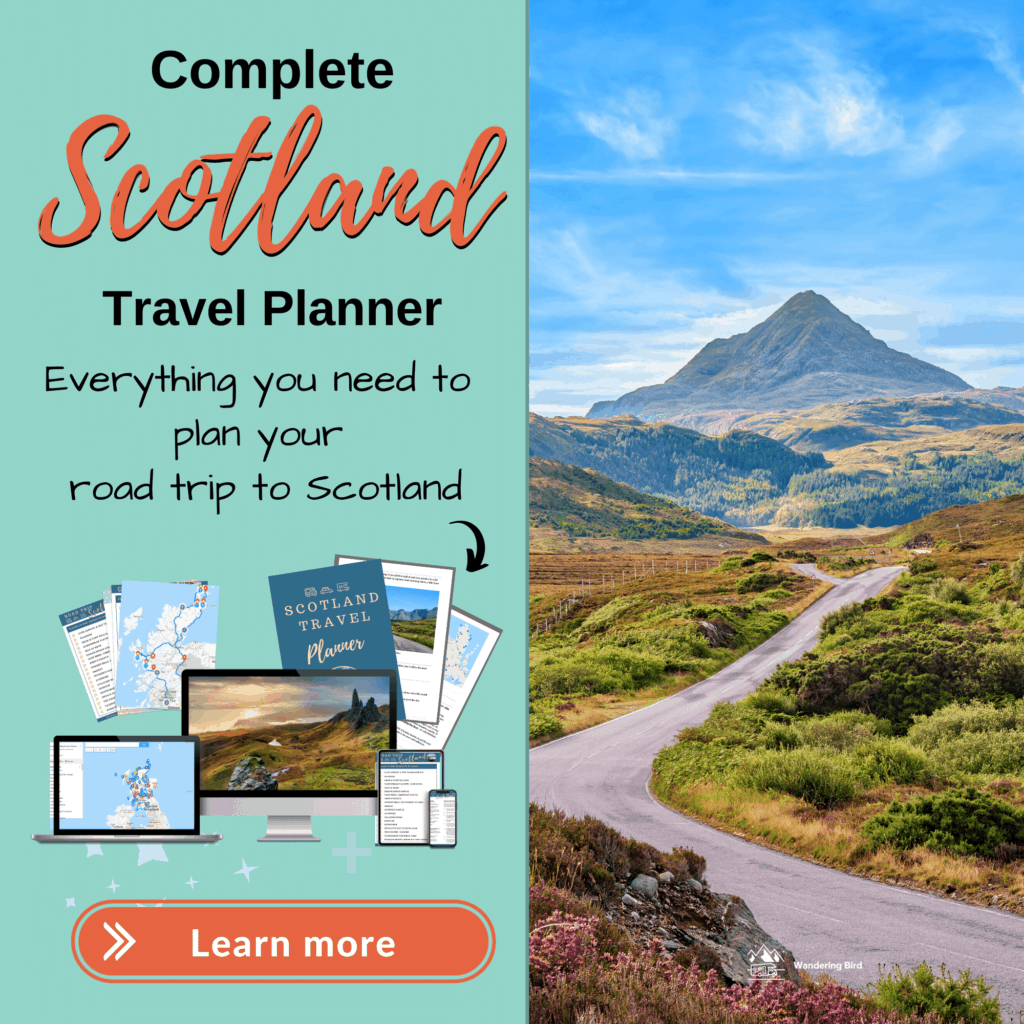
Day Five- Durness to Dunnet Bay
Dunnet Bay is one of our favourite campsites in Scotland. It’s a Caravan and Motorhome Club site, and has the most incredible views.
If you get time, we highly recommend taking a day trip to Orkney. Yes, you can take your motorhome or campervan and get there and back on the ferries.
Day Six- Dunnet Bay to Dornoch (via John o’Groats)
Distance: 73 miles
Estimated Time: 1 hour 42 minutes (not including the detour to John o’Groats.
Campsite Suggestion: Dornoch Caravan and Camping Park
Yes, John o’Groats is cheesy and touristy and overhyped… but you can’t come all this way and NOT get a photo. You can’t drive your motorhome up to the post, but you CAN get your motorbikes up there…
As well as John o’Groats, there are also the stacks at Duncansby Head and the magnificent Dunrobin Castle- the gardens are beautiful and the views are gorgeous.
Day Seven- Dornoch back to Inverness
Distance: 45 miles
Estimated Time: 1 hour
And that’s it- you’ve completed the NC500!
Of course, you can always choose to spend an extra day on the west coast and ignore this day, but there are some lovely things to see in the area, including the Dornoch Firth, Dornoch cathedral, Skibo Castle, Inverness Castle, and hunting Nessie on Loch Ness.
North Coast 500 motorhome hire
If you don’t already own a motorhome or campervan, you can hire one for the trip. Be sure you ask the right questions before you book, as many of the ‘best quotes’ are missing some of the essential things you might need, like bedding or utensils.
Also, make sure that motorhome insurance is included in the quote- that can add a lot otherwise.
Want to rent a vehicle for your road trip?
These might help:
READ: 10 essential questions to ask before you rent a motorhome
When is the best time to explore the North Coast 500 with a motorhome or camper?
Scotland, like many Northern European countries, has ‘proper’ seasons. However, there’s a reason the locals have a phrase- ‘all four seasons in one day’… the weather is famous for changing wildly at the drop of a hat.
It can be sunny in the morning, windy and cloudy by lunch, and even snowing in the afternoon (although it’s rare to get snow in summer.)
The best weather is usually between April-October… but that’s also when this route is at its busiest.
We recommend avoiding driving the NC500 during July and August completely if you can- the schools are on holiday and everywhere is over-crowded. The downside with this route is that EVERYONE is following the same roads, at the same speed, so it’s very hard to get away from the crowds.
Our favourite times are May/ June or October- most of the crowds have gone, but the weather is usually still warm enough and the days are long enough to really make the most of them.
Having said that, rain can strike at any moment, so always be prepared with appropriate clothing, no matter what month you’re visiting.
Spring in Scotland
Spring in Scotland (March, April and May) is wonderful- so many wild flowers and all the baby animals are out to play. Average temperature is 10°C and there is still the high chance of rain, but crowds are fewer and you’ll be able to explore without too many vehicles.
Summer in Scotland
Summer (June, July and August) is peak season in Scotland as it has the warmest months, with average temperatures around 17°C (63 °F). Days are long and the further north you go, the longer the daylight lasts.
Rain can happen, but less frequently than Spring. The biggest challenge during summer is the midges- more on them below.
The main summer holidays in the UK are July and August, so if you are driving the North Coast 500 during peak season, you might benefit from booking up campsites in advance.
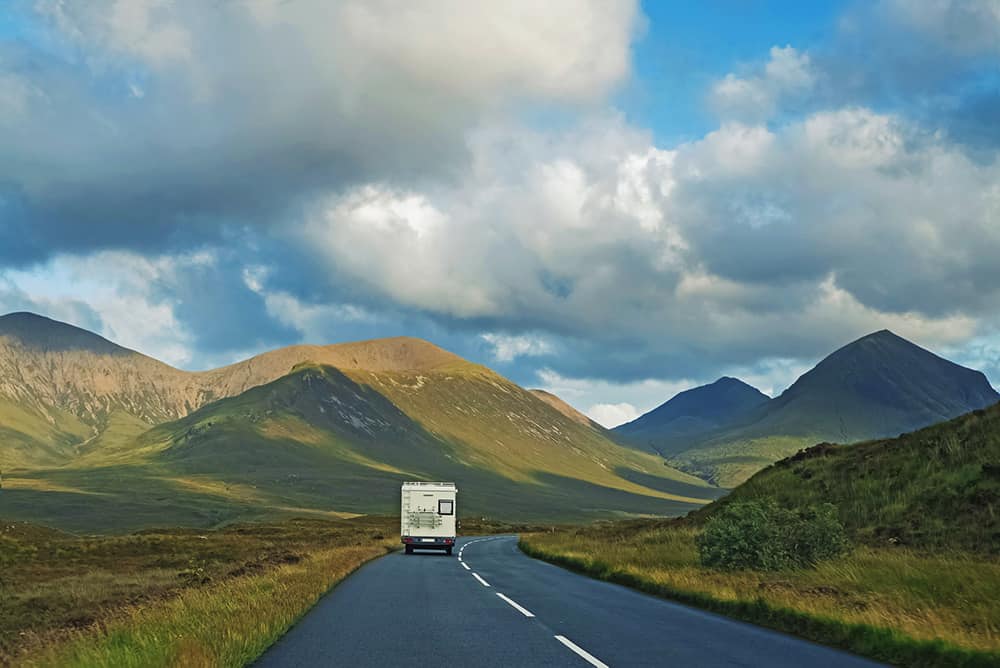
Autumn in Scotland
Autumn (September, October and November) is one of our favourite times to visit Scotland. The changing colours of the leaves, the wildlife and the fairly warm temperatures make it perfect for a road trip.
Average temperatures are around 14°C (57°F), but drop sharply in November.
Winter in Scotland
December, January and February are usually the coldest months, with average temperatures of around 5°C (41°F). The daylight hours are also much shorter and there’s a high chance of snow, especially in higher regions.
Whilst we enjoy motorhoming all year round, winter can make campervanning in Scotland more difficult than during other seasons.
Many of the campsites close so, although the roads are quieter and you’ll have some incredible locations to yourself, you might find emptying waste or getting fresh water more difficult.
Having said that, one huge advantage of driving the North Coast 500 during winter is the chance of seeing the Northern Lights– yes, you can occasionally see them in Scotland.
Midge Season in Scotland
You may have heard of the midges in Scotland- small flying biting horrors which can turn a pleasant evening into a miserable affair.
Sadly, despite not being a target for mosquitoes, they seem drawn to both me and my husband, so now we make an effort to avoid peak season, which is May to September.
Some tips to combat the midges if they are out to get you are:
- Stay indoors at dusk- that’s when they’re at their worst
- Light Citronella candles/ use citronella spray
- Use Avon Skin So Soft body spray (this thing is awesome!)
- Wear a midge veil/ hat
- Stay away from still water
- Go somewhere windy (no jokes about baked beans please…!)
Another horrible insect/ bug to be aware of is ticks- especially if you have pets. They are common all over Scotland, so make sure you check your pet and yourself frequently, especially if you’ve been hiking or walking in long grass.
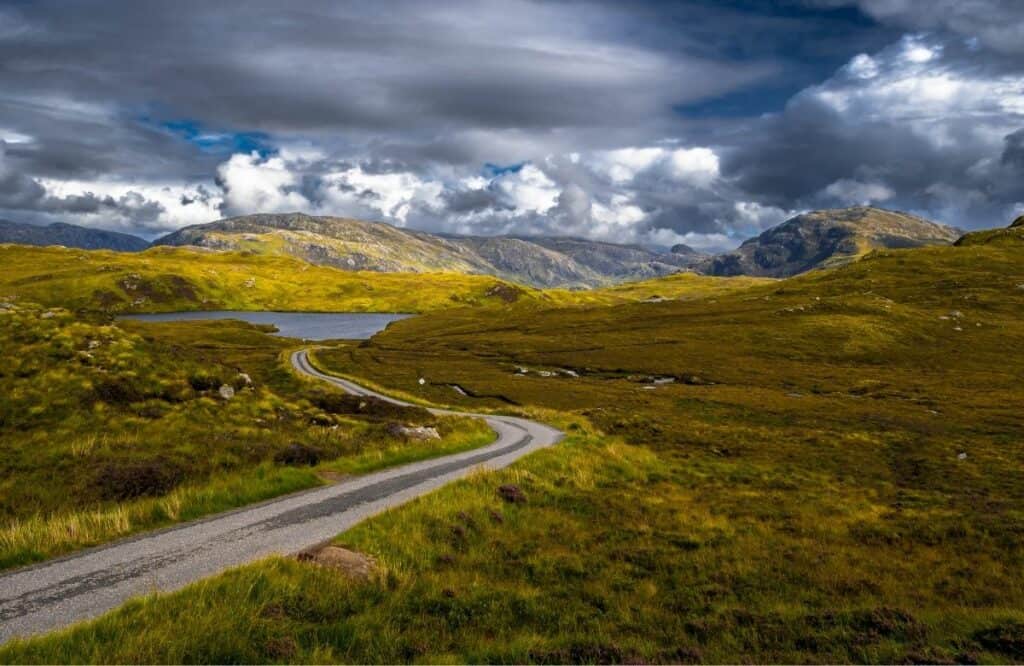
Wild Camping with a motorhome on the NC500
We love motorhome wild camping in Scotland. It’s one of our favourite ways to explore and we enjoy staying away from campsites and enjoying the beauty of nature.
However, as you may have seen in the news, the NC500 has had some difficult and heartbreaking experiences recently.
Learn more about how we find free overnight motorhome parking stops in the UK and Europe
During the summer of 2020, there were countless stories of selfish and ignorant van owners leaving places damaged and strewn with all manner of disgusting waste.
It was awful and I don’t blame the locals for being angry. It made me angry that a few selfish idiots were ruining the experience and reputation of every other motorhome and van owner and tarring us all with the same brush.
At the moment, tensions are still high between the locals, the councils and van owners. The truth is that the popularity of the route has grown to the point that the infrastructure can no longer support the numbers of visitors- especially those who bring their own vans.
For that reason, we currently do NOT recommend wild camping along the NC500 until the area (and the hurt feelings of the locals) subside- we suggest finding approved overnight motorhome parking spots near you instead.
The councils are apparently working hard to create new areas for motorhomes and campervans to stay and we highly encourage you to use those whenever you can.
Motorhome wild camping guides for the UK & Europe
For information on how to find good wild camping places, WHAT to do when you’re there and how to stay safe, check out our step-by-step guide for motorhome wild camping in the UK and Europe, complete with database of 250+ overnight spots we’ve stayed with our motorhome.
Don’t forget to grab your free wild camping checklist here
North Coast 500 motorhome Campsites
The North Coast 500 has many lovely campsites, many of which accommodate motorhomes and campervans. We’ve listed some suggestions in the North Coast 500 motorhome itinerary above, but there are plenty more during summer.
The problem with many of these campsites is that they close during winter and the off-season, so it’s quite hard to get water or empty waste or find overnight parking in these times. Still, there are a few which are open all-year round.
TOP TIP: Many campsites only allow you to check in from 3 or 4 p.m, and then the office closes around 7pm. Timing your arrival can be tricky, so allow plenty of time to make sure you don’t arrive too late.
If you’re early, there’s no harm in turning up and seeing if they will let you check-in early- most places are very accommodating if they have space.
As well as campsites, you could use Brit Stops to help you find places to stay overnight.
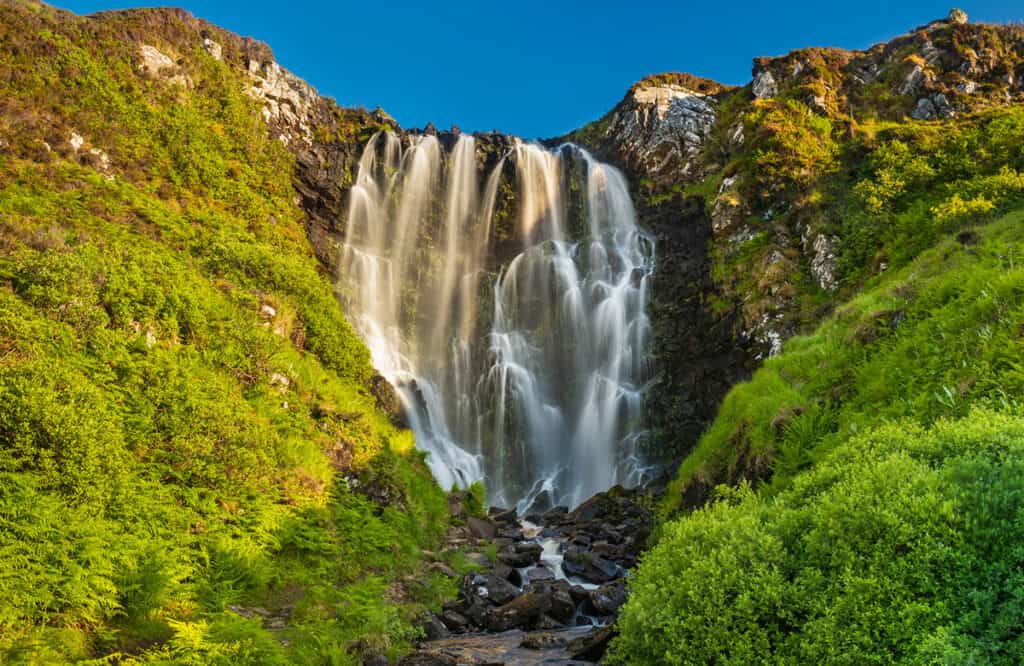
Tips for driving the NC500 with a motorhome or camper
- Be aware that many of the rural roads are single track and there is a lot of farming in the area, so you may well encounter farm vehicles and animals on the road.
- In addition, the wildlife in the area is abundant and it’s common to see foxes, deer, badgers and other animals on the roads. Be careful, especially at night.
- On a single track road, if you encounter a vehicle coming towards you, expect there to be a moment where you stare at each other to see who will blink first. If you’re in a motorhome and are facing a car, there’s a high chance they’ll reverse to allow you to pass (be sure to thank them). However, if they’re really not budging, or if you know there’s a passing place close to you, you can indicate that you will reverse for them, unless you have a vehicle behind you… which is when the fun really starts. On hills, the vehicle going uphill has priority, so the vehicle going downhill should reverse but, again, a car might well reverse for a motorhome.
- Talking of which, if you are driving slowly and holding up traffic, use a passing place to wave through cars, bikes or anyone stuck behind you- they’ll thank you for it.
- Do NOT get sucked in by another driver telling you that ‘you can get a bus through there’. Car drivers are not always used to the width of motorhomes, and are frequently wrong about what you can/ cannot get through safely. If you’re not happy with the space they have left you, either ask them to move over more, or you reverse until you find a passing place you’re happy with.
- Similarly, be alert for vehicles reversing towards you. Stop immediately and see where they are going. Also, be aware that they may not see you. Some drivers get so intent on reversing straight and not hitting the side of the road that they forget to look straight behind them. If they get too close, beep your horn.
NOTE: a passing place is NOT an overnight parking spot. Nor is it somewhere to park up and go for a walk/ take a photo/ make a phonecall. If you block this space, you block the road, for both tourists and locals. Please be considerate.
- Having a paper map is a good idea, just in case. Also, if you have wifi in your motorhome, some areas have very poor signal, so it might not always work.
Here are some other guides you might find useful:
Don’t forget to grab your motorhome logbook to record all of your amazing adventures!

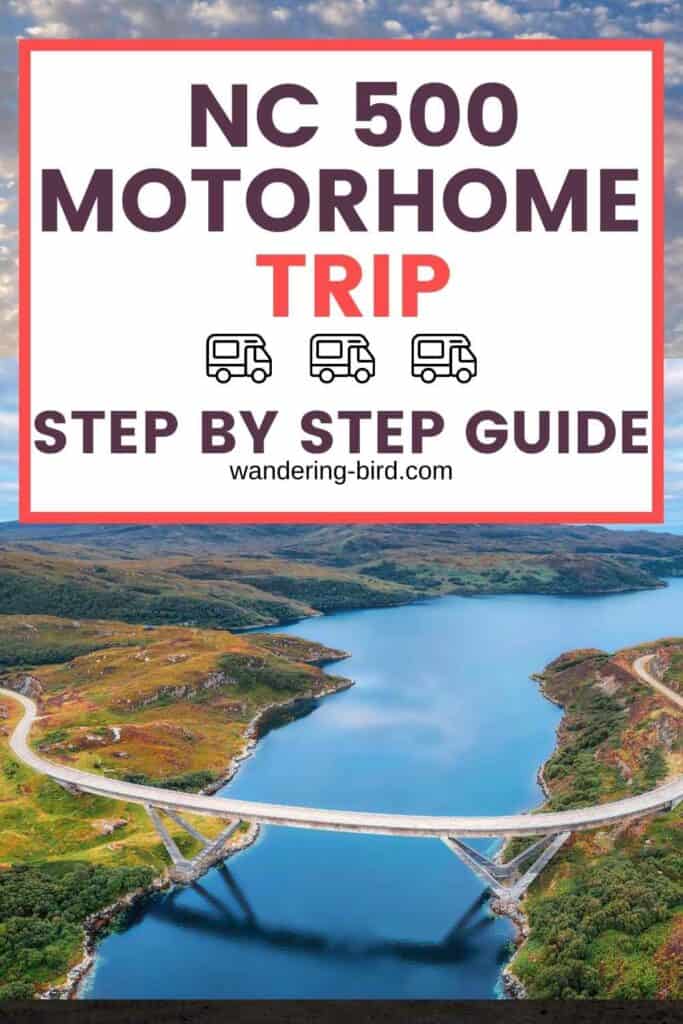


Kat never planned to buy a motorhome. She also never planned to quit her job as an air traffic controller, go touring around Europe in said motorhome, start one of the UK’s largest motorhome travel websites… or get a cocker spaniel.
Find out how she went from stuck in the rat race to being a digital nomad and inspiring thousands of people to have their own epic adventures here.
If you’d like to connect with Kat, send her an email or follow her adventures on social media.
Last update on 2024-04-27 / Affiliate links / Images from Amazon Product Advertising API


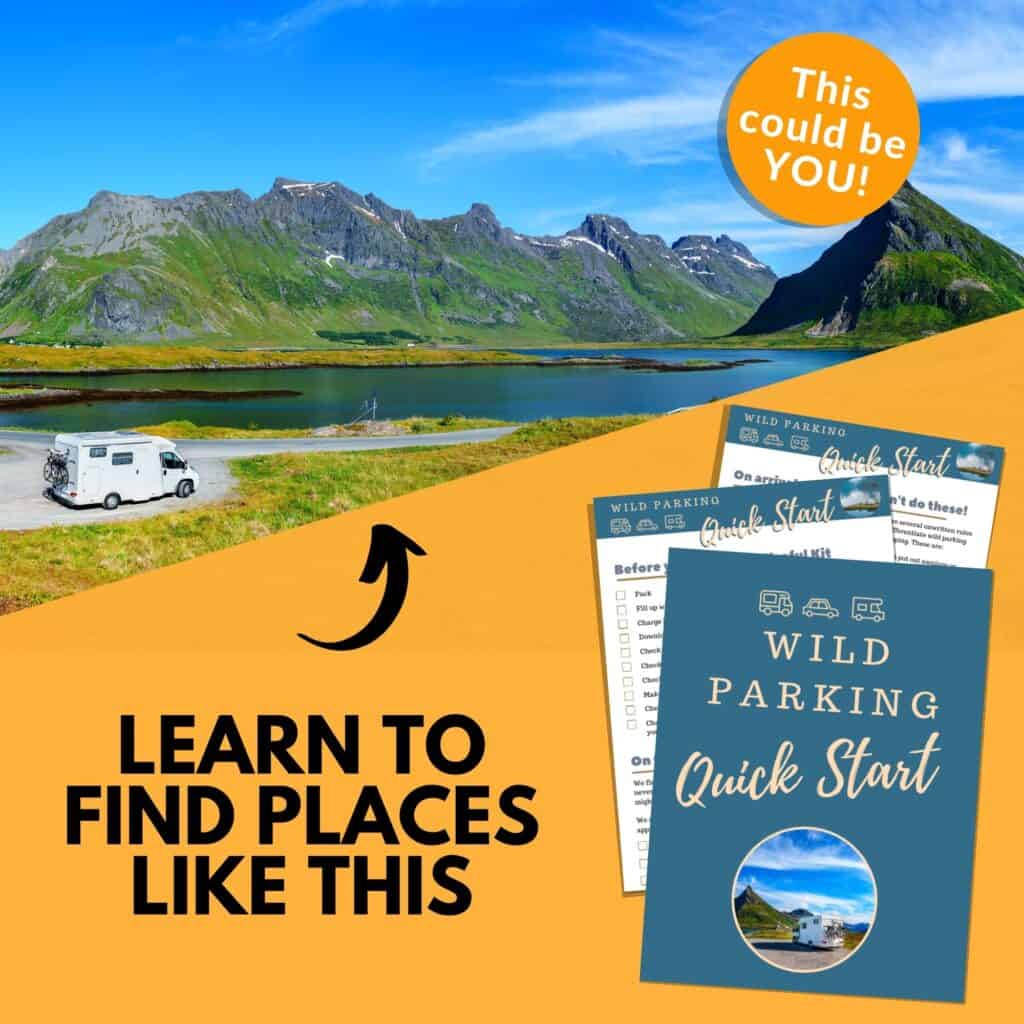




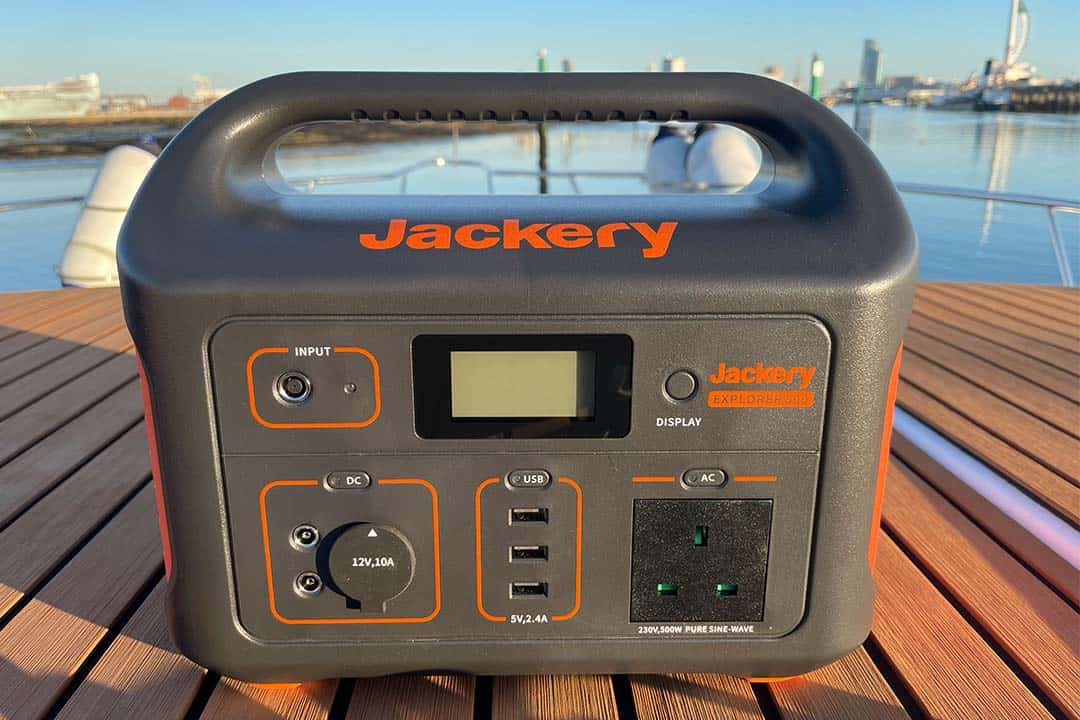
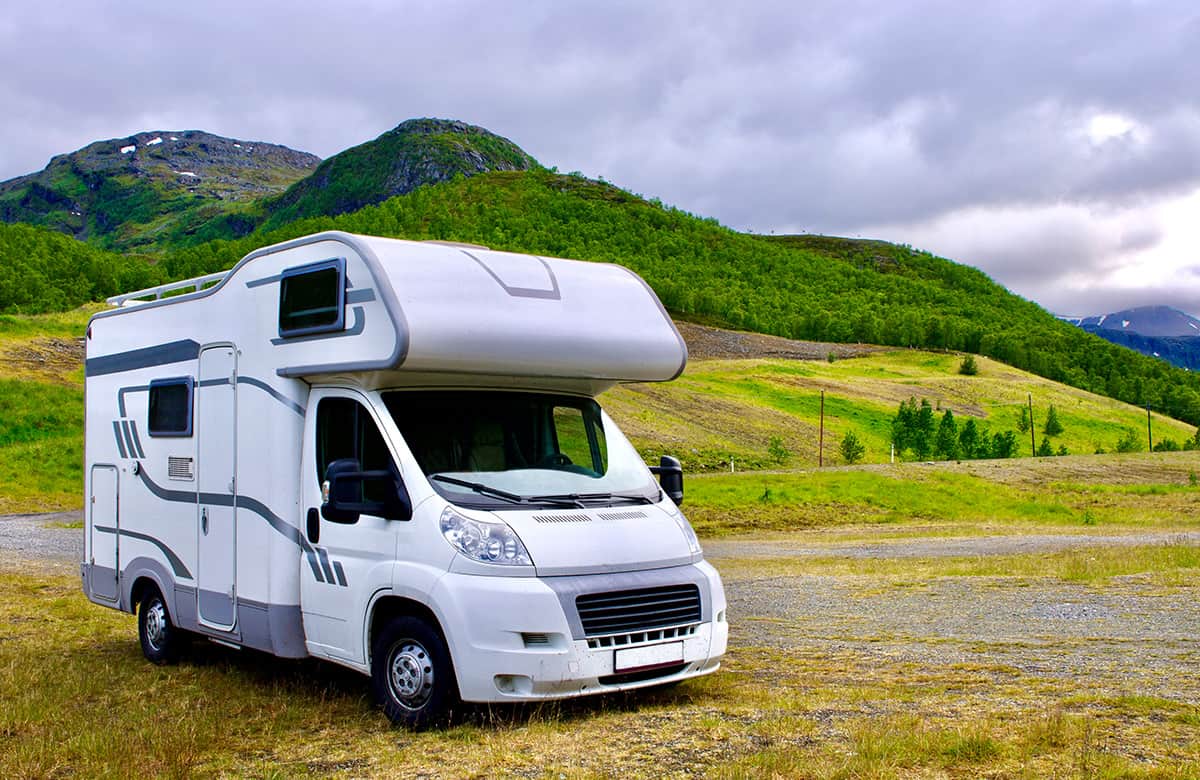
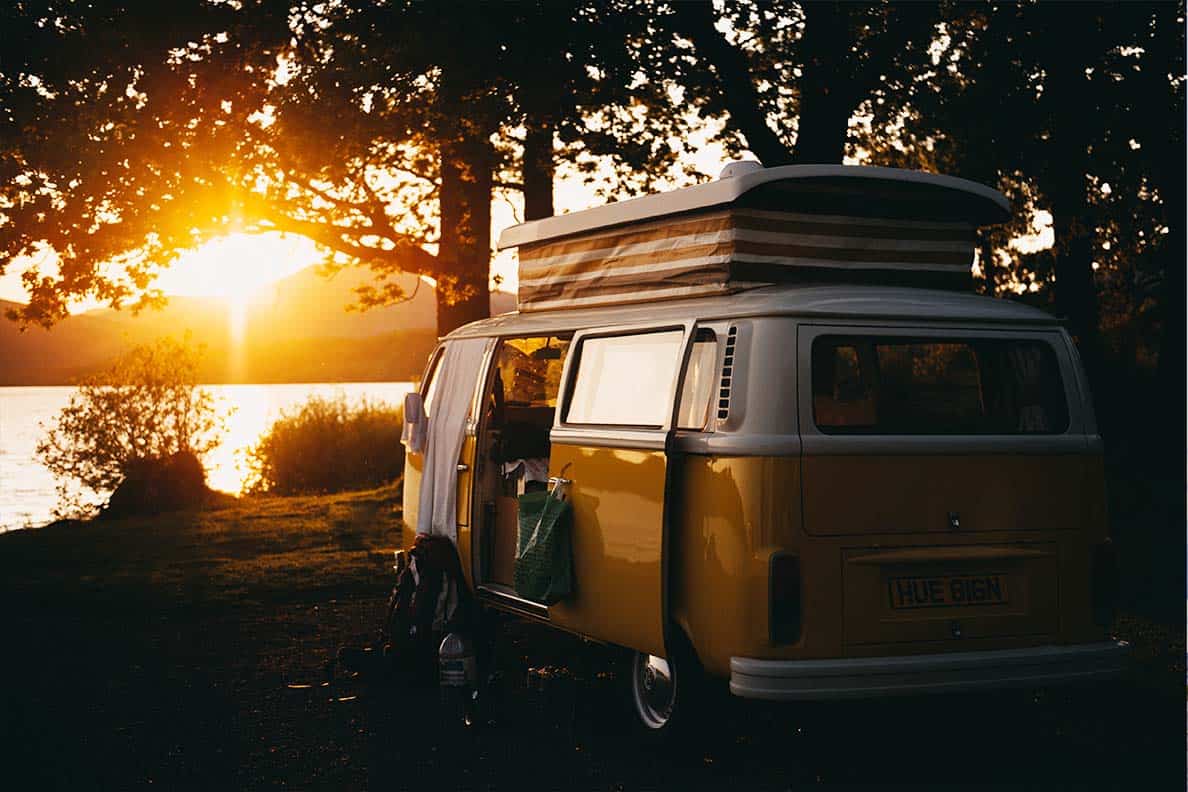
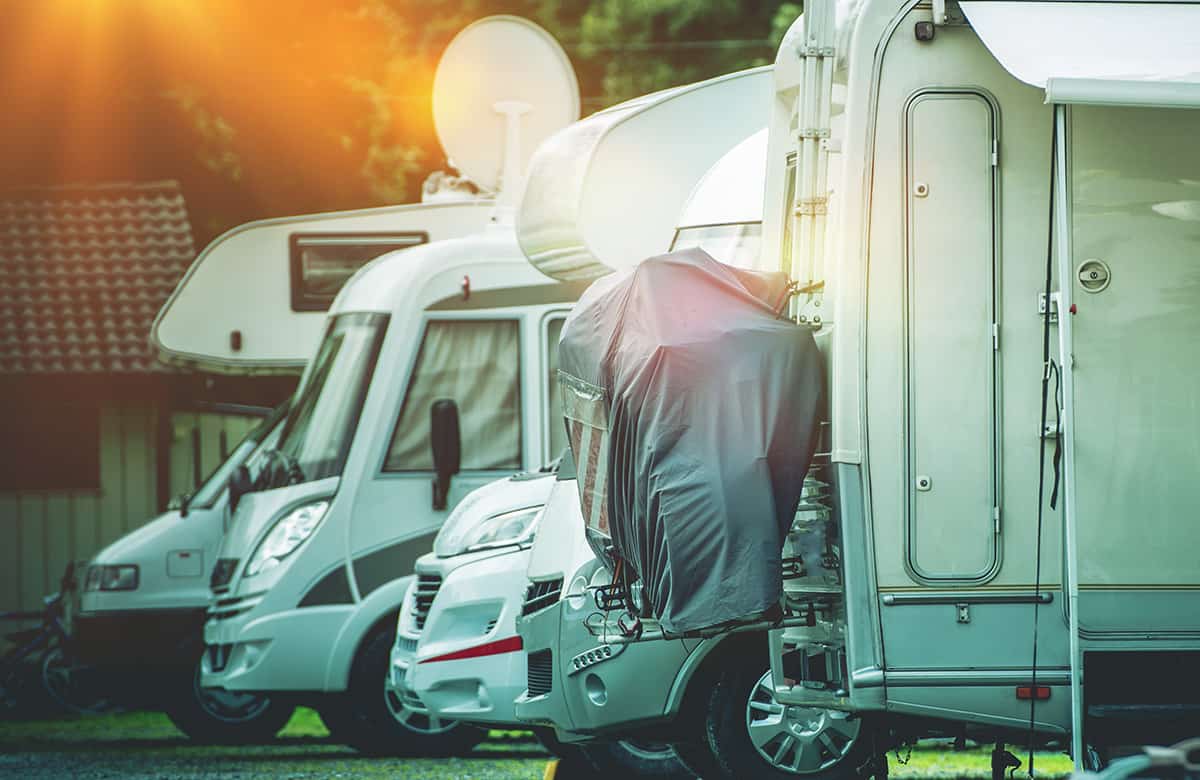
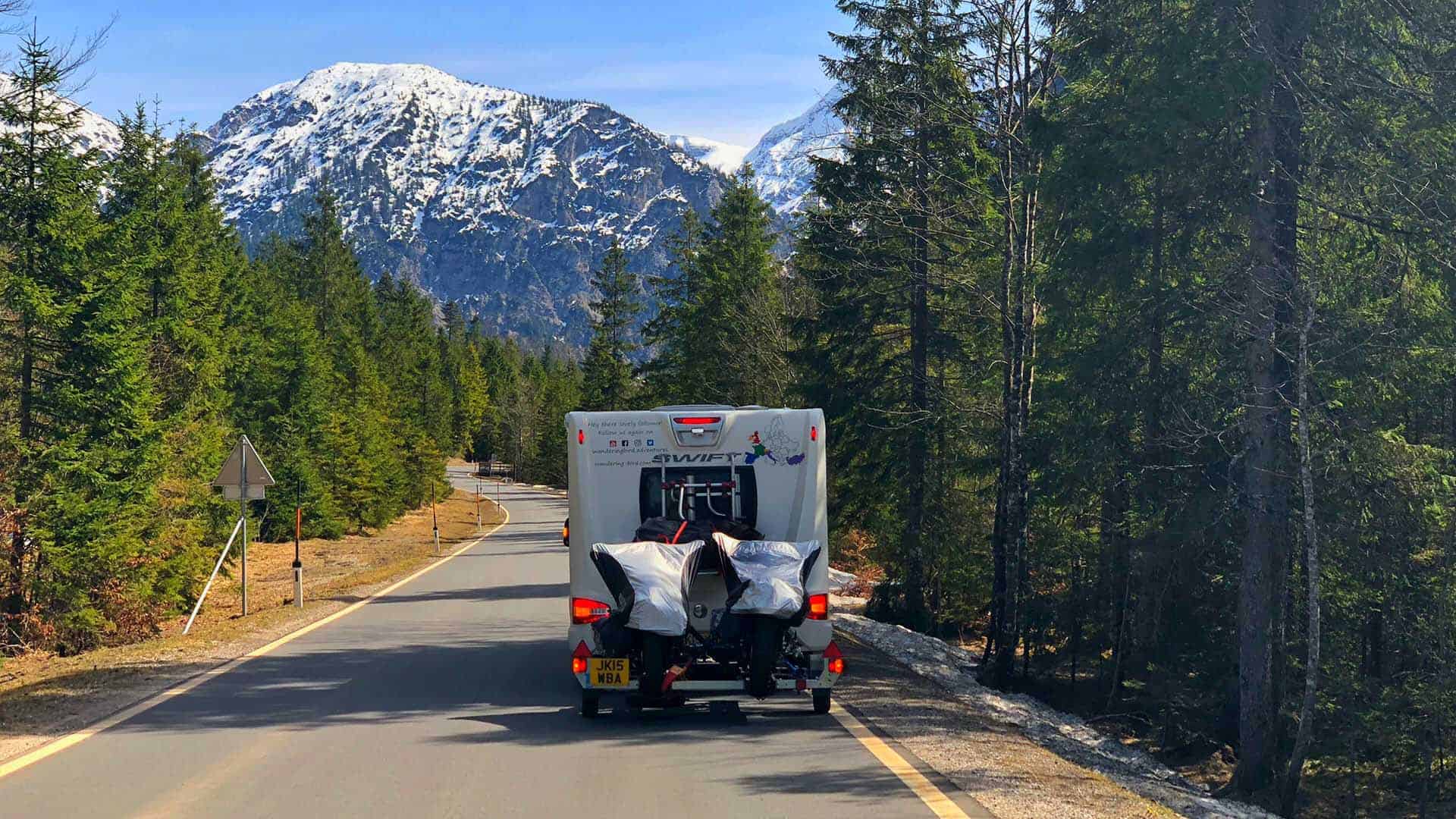
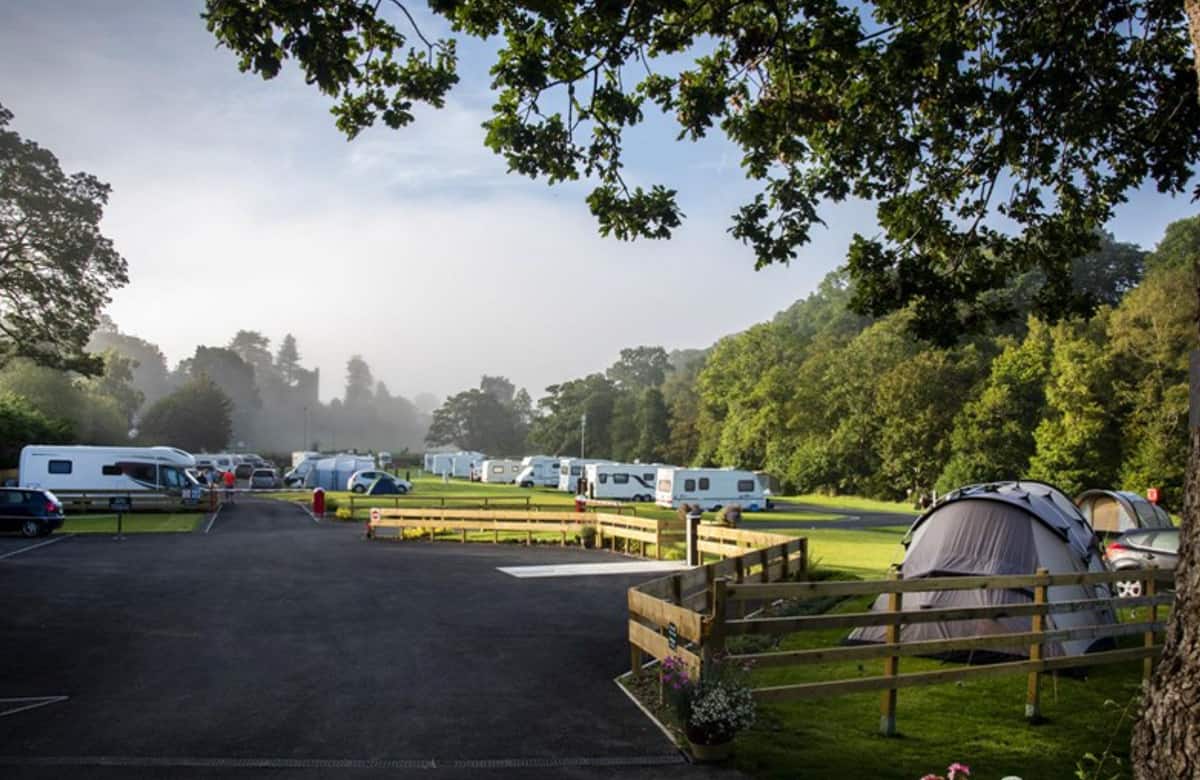
Great information well worth the read
Thanks so much
You’re very welcome. Glad it was helpful. Enjoy your Scotland road trip! 🙂